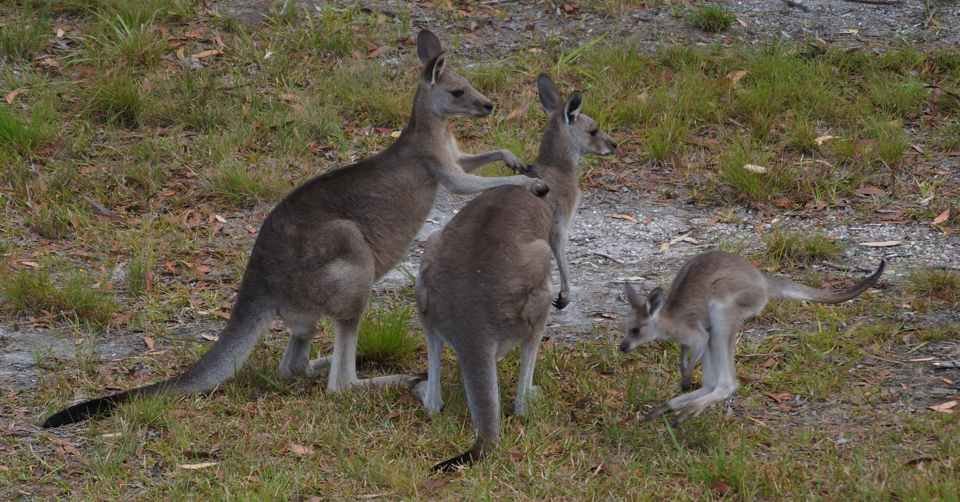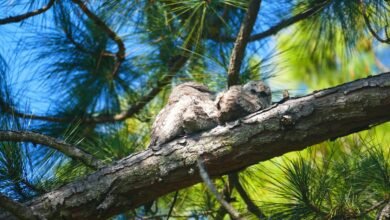Eating Kangaroo?


Macropods are wonderfully adapted to this continent, In drought a female kangaroo can re-absorb her waiting embryo; chances of survival are far greater without a foetus attached to the nipple as well as a joey in the pouch. The females usually have a production line of young, one out of the pouch but still drinking milk when necessary, a baby still developing attached to the other nipple, and a fertilised ovum, an embryo that develops until it consists of 20 cells then stops in suspended animation until the young attached to the teat, leaves the pouch, it then resumes development. Milk from each nipple varies in composition to match the development stage of the young. There’s no breeding season, the female is ready to mate as soon as the embreyo resumes development. This is a maximising reproductive strategy. In bad droughts her milk supply stops and both of the young feeding from nipples can die, following which the embreyo resumes development. A female Red Kangaroo can have a young becoming independent every 240 days. There is a high mortality at the stage when they leave the pouch, but in good times they can build up their numbers rapidly.

Europeans killed kangaroos initially for food then for fun and then to protect farming.
“By the 1880s, all of the states of eastern Australia had introduced legislation for the destruction of kangaroos and wallabies. For example, NSW’s Pasture and Stock Protection Act 1880 declared kangaroos and wallabies to be vermin and bounties were offered for their heads. As a result, a massive number of these animals were killed.” Keely Boom
Most state wildlife authorities now manage kangaroos as a ‘renewable resource’ and advocate `farming’ kangaroos’, the meat is healthy and kangaroos are soft-footed animals that have evolved here and don’t cause land degradation unlike hard-hooved livestock for large areas of arid and semi-arid Australia. The growing population of sheep and cattle is biggest human-related source of the greenhouse gas methane. The scientists say not enough attention has been paid to tackling greenhouse gases other than CO2. Grass fed meat is more expensive but less environmentally harmful than grain fed, grass is a naturally growing food that we can’t eat yet ruminants turn it into a delicious rich protein meat.
Chicken is one of the most efficient meats, it grows fast and the manure is useful, but battery farming is a foul practice slowly ebbing. Meat production accounts for 80% of the nitrogen and phosphorus used in farming, causing pollution (reactive nitrogen contributes to air pollution, fuels climate change and is estimated to shorten the life of the average European by six months). Farming also causes deforestation, a rapidly-growing problem in areas like Africa, Central and South America and a major problem for a healthy environment.
Land clearing in Australia is still going on after disastrous policies especially in Queensland. Oct 23, 2013 – Summary. New research from NSW and Queensland has found that Australia’s land clearing rates are much higher than previously estimated: “The research indicates that Australia is clearing 687,800 hectares (6,878 square kilometres) of native vegetation every year. Approximately two thirds of this is virgin bushland. This is higher by 22% than the earlier estimates of 564,800 hectares being cleared annually. This means that over 50 “football fields” of Australian native trees, wildflowers and wildlife habitat are destroyed every hour.”
Clearing increases erosion, salt damage, sedimentation of waterways and reduces water quality. Clearing removes habitats leading to the direct loss of millions of native animals and plants every.

So is roo farming the answer?
The kangaroo industry takes 3-5 million animals per year and uses ten species of kangaroo and wallaby. Animal rights groups claim the industry is inhumane. Research by the RSPCA found that there is a far higher degree of cruelty in non-commercial killing than in commercial killing. Kangaroo shooters’ vehicles criss-cross fragile outback terrain, causing erosion and disturbing rare fauna and flora
There was growing market for kangaroo meat for petfood and leather, used for soccer shoes for example. Adidas has banned kangaroo leather concerned for the welfare of dependent young kangaroos killed or abandoned during the kill. Every year over a million dependent young die as collateral damage to the commercial kill (University of Technology, Sydney think tank on kangaroos – THINKK) Russia banned kangaroo meat after finding high levels of bacterial contamination.
The Australian Society for Kangaroos point out: “According to scientists at the UTS, the number of kangaroos necessary to replace meat production from sheep and cows is ecologically unfeasible. They found that to provide Australians with just one small portion of kangaroo meat per week, 22 million kangaroos would have to be killed every year. The total population of kangaroos would need to be 151 million to support this off-take. This is more than five times the 30-year average population of 27 million, to provide one serving of meat per Australian per week. Therefore the “go green, eat ‘roo” push is sham science.”
Sustainability is a no-brainer, but we all know are now living beyond our means with a population of 7 billion. People are living longer, and 1.8 billion women are in their childbearing years that the population will keep growing, even though each woman is having fewer children than before. By 2050 the total number could reach 10.5 billion, or it could stop at eight billion—the difference is about one child per woman.
We forget that everything we do, that we create, waste and consume has an impact on the environment. Answer: Less people, less ruminants, less steaks and roasts, more sausages (hard to find free-range) and veg.
The Australian environmentalist Val Plumwood who was a vegetarian advocated a semi-vegetarian position she called ‘Ecological Animalism’, which meant eating less meat, and treating animals with respect.



